The large and varied collection of stuffed and mounted animal specimens at the National Museum of Nature and Science in Tokyo includes several famous canines.
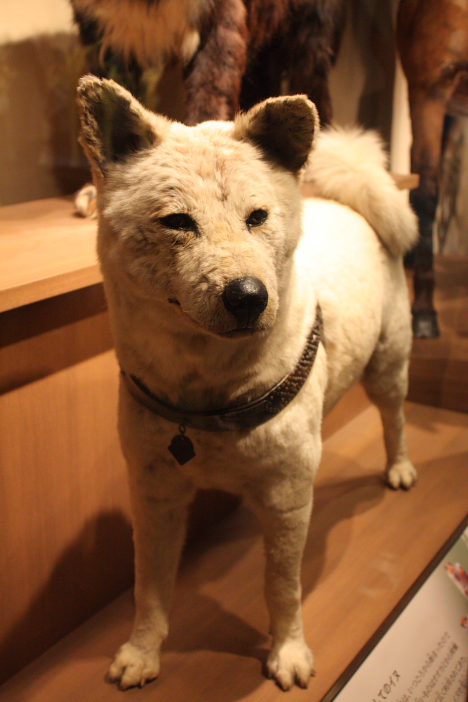
Hachikō
The preserved body of Hachikō -- Japan's most famous dog -- is on display on the second floor of the museum's Japan Gallery wing. An Akita dog born in 1923, Hachikō is remembered for his deep loyalty to his owner. While his owner was alive, Hachikō would greet him at the end of each day at Shibuya station when he returned home from work. The man died in 1925, but Hachikō kept his daily routine, faithfully waiting for his owner every evening at the station for 10 years until he died in 1935. Hachikō's permanent presence at Shibuya station attracted widespread attention, and his legendary faithfulness became a national symbol of loyalty. [More]
* * * * *
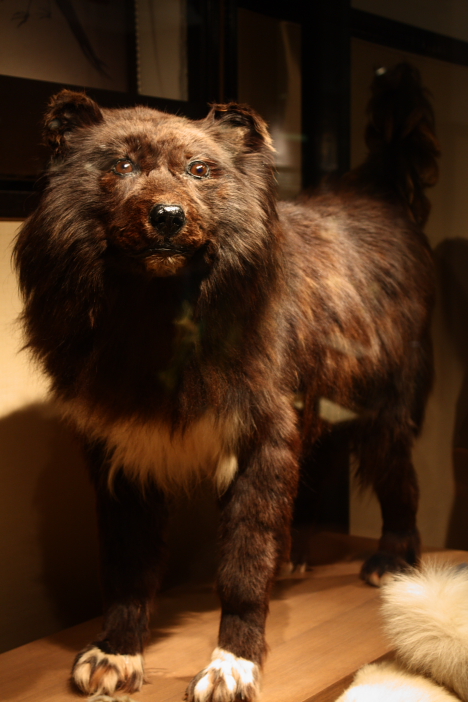
Jirō
On display next to Hachikō is the preserved body of Jirō, one of two Sakhalin Huskies famous for surviving a year in Antarctica after being abandoned during a failed scientific expedition to the South Pole. In February 1958, a Japanese survey team stationed in Antarctica left their base after extreme weather conditions prevented a replacement team from reaching the site. Thinking they would return soon, the team left 15 Sakhalin Huskies chained up at the unmanned base. However, due to fuel shortages, nobody was able to return for nearly a year. When the next survey team returned to the base in January 1959, they found that two of the dogs, Tarō and Jirō, had miraculously survived the ordeal. [More]
* * * * *
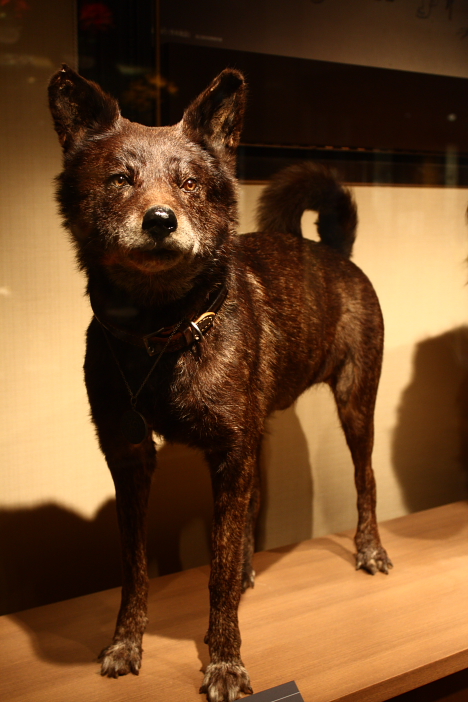
Kai Ken
Alongside two of Japan's most celebrated canines is the preserved body of an anonymous Kai Ken (a.k.a. "Tora Inu" or "Tiger Dog"). The Kai Ken is a rare breed of dog considered to be the most ancient and purest dog breed in Japan. Developed centuries ago in the isolated district of Kai (Yamanashi prefecture), the breed was used for hunting boar and deer. The Kai Ken breed was designated a national treasure in 1934. [More]
* * * * *
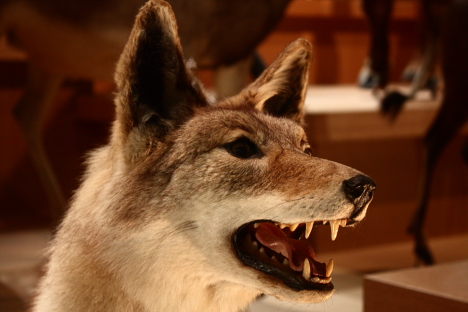
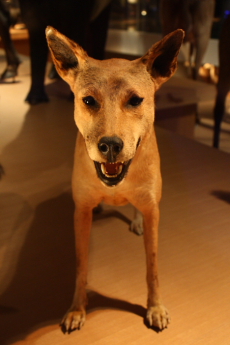
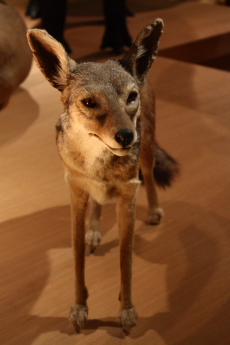
Other canine specimens on display at National Science Museum
* * * * *
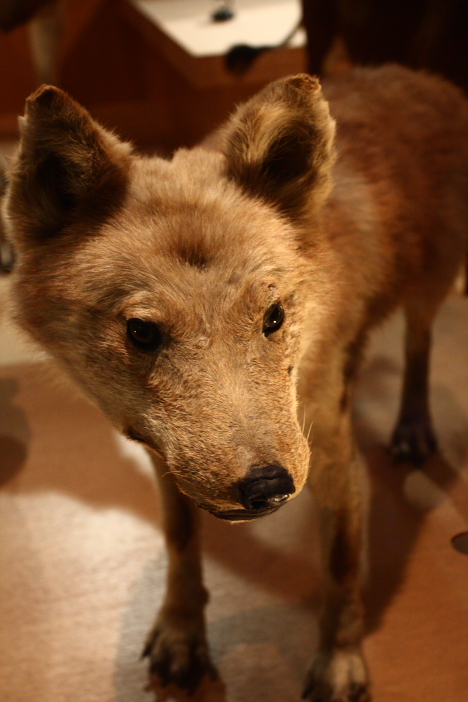
Honshū Wolf
On display in the museum's Global Gallery wing (third floor) is the preserved body of a Honsh? Wolf (Canis lupus hodophilax, or Nihon Ookami), one of two extinct species of Japanese Wolf (the other is the Hokkaido Wolf). This species, which once occupied the islands of Honshū, Shikoku and Kyūshū, is thought to have become extinct due to a combination of rabies and human eradication. The last known Honshū Wolf is believed to have died in 1905 in Nara prefecture, though the exact date is disputed (and sightings are still reported occasionally). The stuffed specimen at the National Science Museum is one of five known to be in existence. [More]
* * * * *
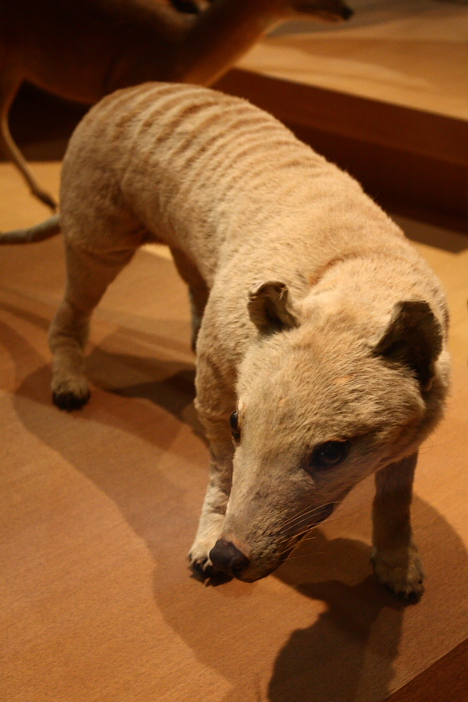
Tasmanian Wolf
Another rare specimen on view is the Thylacine (Thylacinus cynocephalus, a.k.a. "Tasmanian Wolf" or "Tasmanian Tiger"), a large carnivorous marsupial (not a canine) native to continental Australia, Tasmania and New Guinea, which is believed to have gone extinct in the 1930s (though sightings are still reported). Here is some footage of what is believed to have been the last living Tasmanian Wolf, filmed in 1933. [More]

kl81523
is that really hachiko cool he is still there and it feels like he's really alive but that is his body but that works for me
[]jadarius
i like so much
[]hy7yuy78
wrong this is wrong
[]Love Hachi
So that is the real Hachiko? It nice that they preserved him. Loved the movie and the dog.
[]diAnnEo4_14
....hachiko was really loyal to his master....i think you can never see a dog like that anymore....it's as if he has a mind of a human and can feel and care to his master like that of a human...the story was really touching...he is a true man's bestfriend....love you hachiko!!!!you're my idol.... dianne from the philippines....
[]Earl philip
Im from philippines 2
[]Brian Kwong
Hachiko body should be Reunited with his master not seperated for 70 years from him.
[]89chiyoko1
...:-) only the fur is stuffed and preserved, but the bones are buried together with his master....they're together now....
[]nathaniel
is it true?
[]im from phil
Janice
I totally agree with you Brian Kwong, I have only just watched the movie for the first time, and it was so very sad. But great movie all the same..
[]Chelsea
I agree :( sad he was never properly put to rest with is owner as i imagined he had been :/
[]Shivani
You read everything about Hachi. You talk about him possessing human like traits of loyalty. But then in the end, after all the humdrum, you bring him back to his place as an animal, as a fucking showpiece by stuffing him and putting him on exhibition. If he was so "human" you could show him some humanity And give him a proper burial or a resting place, you swines.
[]Nymiura
Calm down. You do realize that HUMAN bodies are in display in museums, so saying treat him like a person sounds stupid. Hach had a family. His owner was married with children. He was “donated” but if I’m not mistaken his bones were buried alongside his owner.
[]fgfrtbc
thats not the actual body he was buried right next to his owner when he died
[]S
His body was cremated, his fur/pelt preserved so they could taxidermy it
[]Brian Kwong
Many Buddhists believe that the soul does not immediately leave the body after death, so it is important to treat the corpse as a person not as an object.
[]Ravenleaf
Poor Hachiko! I'm watching Hachi, the movie, right now. It's SO sad! Makes me want to cry...
[]Iman
After I read http://en.wikipedia.org/wiki/Nankyoku_Monogatari, my heart touched. I salute Jiro and Taro! I love dogs!!
[]Akits_247
In my opinion they should have put Hachiko in his famous position.
[]Brigid
My 3rd grade teacher read the story "Hachiko Waits" to us. Now I'm in 5th. I still find this the saddest and most touching story I have ever heard. He waited 10 YEARS for his owner. He died in the very exact spot he last saw his owner. Now he's up in Heaven with him.
[]Brigid
Did you also notice most of the comments are about Hachiko?
[]hi
Yes its very touching story
[]claudia
hachiko will always shine apon us i do wish i was from that time so i can see him i couldnt belive my eyes when i found out that it was based on a true story that dog is undescribale i just cant belive that really happened its just amazing
[]claudia
shine the light apon us hachi
[]Hachiko Fan
Awwwwwwww!!! Saddest story ever!! at least they are together it heaven now. I LOVE Hachi!!!!
[]Crystal Jane
.Hachiko is realy sweet...I hope you and your master saw each other..and leave in another life...I wish that they buried you with your master..Your story touched Filipino's heart...I love You..
[]89chiyoko1
hey crystal jane.... :-) yah...they did! they remove the fur and preserved it....and have it stuffed and displayed in ueno museum, but the bones and other parts of his body are buried together with his master..... i really love hachiko...i even downloaded the movie and put it on my cellphone.... so i can watch it everytime i want to...
[]Chris
I know Hatchi and his master are in heaven together. They removed the hide (skin and fur) then stretch it over a foam resemblance if Hachi's body. I agree his other body parts are buried along side of his master forever ! I LOVE the idea that have Hatchi showcased there at the museum. I LOVE that people can see a young looking Hachi instead of him looking so old in the photos I have seen. Loyalty and love is a human trait but also n our pets. Dog and cats and other pets have the same traits, love and compassion as well. When a person or animal like Hachi die their soul leaves their body. I have seen the movie twice and cries so much. Hachi is the star and I LOVE him so much !!!
[]Gd Bawa
This movie is really very good. The loyalty of Hachiko made me cry while i was watching the movie.. really touched my heart...love u HACHIKO
[]Santo
So Touching T.T,, Love Haci :)
[]lex jerome
,,so touching i cry ....
[]kara
I love the movie 8 below, and finding out it came from a real life, is wonderful I guess because where Jiro and Tiro where born maybe the reason why they both lived. But its wonderful that all the dogs are stuffed and remembered. They worked hard.
[]And where loved dearly.
Michelle
i love you hachiko!
[]Chele
The story of hachiko is very touching.i love u HACHIKO! :)
[]Elizabeth Anne
In my opinion, Hichiko's body should have been burried, placed into his owner's grave. Then they would have been reunited, not still separated after all these years.
[]89chiyoko1
they did buried them together in the grave....they only got the fur to preserved it..... according to the reliable sources...
[]mongbaprince
Where is your reliable source, I wanted to know if your actually saying the truth. Poor Hachi if you don't or if your source was actually lying.
Anyhow stuffing him and burying his internal remains I think was still injustice, it's like as if they bought the rights for his outer covering and just throw away his unwanted parts just to exhibit him on public.
If I were the owner I wouldv'e wanted him as a whole. ; / and wouldn't Hachi want that too?
I mean he can't live for that 9 years waiting without a single part on his everything. And they just used it.
If this was made in memory of him, then put a monument next to his burial place and just relieve his story on the Museum not stuff him and display.
[]Kate
monbaprince, I COMPLETELY agree with you! They should have buried that poor dog next to his master WITH his fur and coat etc.. I would never want my dog stuffed.. it's so sad .. almost like they are still not together or not at peace when half of his body is in a museum and half buried. Wish I could have fought for his rights. I wonder if they are together (spiritually) now. But kind of disturbing that they have stuffed this guy, a photograph would be just as good.
[]Alene
HachikÅs story is beautiful. Thank you for the pictures and the wonderful stories...
Alene
[]USA Florida
Linie
Hachiko's story is extremely sad. He was a very special and beautiful creature that touched (well, he still does) many people's hearts. Curiously, many people didn't help him and instead neglected him. I wish with all my heart that heaven exists and Hachi and his master are together again, being as happy as one can be.
They shouldn't exhibit his body like this, he's not a body. I think that's selfish. The best way of honouring him would be burying him next to his master. That would be showing him our love, for real :)
[]89chiyoko1
yah...they got only the fur...but the rest of his body parts and bones are buried beside the masters grave.......so they're still together....
[]Josh
89chiyoko: Look man! If you die and someone took off your skin and buried the rest, won't you feel unhappy... and Hachiko waited for his master's arrival 9 years after his death.. wouldn't he won't to be buried the whole so that he may rejoin his master... and I have heard somewhere that if one is not buried the whole, his spirit remains in this world.... and after waiting that long Hachiko has to wait for many decades still to come and more... The story touched my heart and I wanted to see the real Hachiko but a picture of his would have been enough......
[]Gina Fe Bernaldez
Hachiko made me cry ..even just remembering the story...I hesitate to see it again because it really breaks my heart.. If I were the master's wife, I would not allow Hachiko to be homeless... I would watch over him and not leave him alone... But why did they allow Hachiko to be alone! Poor Hachiko! You don't deserve that treatment.. But anyway, I really pray God will let me see you in heaven..Please God!
[]Suzi Dang
Gina Fe Bernaldez relects my thinking Professor Ueno's wife and daughter; wife must have commitment with Hachi; she should not abandonned him for many years like that; poor Hachiko, I love you and I wish I were your owner's neighbor at that time; you would be left homeless and unloved; wandering in the street days and nights. So sad!
[]Josh
Didn't Hachiko want to wait for his master's arrival as he thought he would return to him and play with him again... If the wife would've taken him elsewhere he would've still come back to his spot.... This was what he wanted.... He showed the loyalty and love towards his master by waiting this long..... But I do not like the thought of him living him as a stray.....
[]Gabby
listen, he was not married, in the movie and the book it specifically siad they tried everything from keeping him form leaving.sadly he would not leave his master, he was such a great dog, i wish i couldve done something. bless his heart Hachiko will be remembered world wide.- gabby
[]DaniiSushy
Hachico <3 ii love that dog, ii had an akiita, theire really loyal.
[]Hachico made me cry, and miss my father who had a strong connection with my akita, sushy.
soneul
i'm honestly really happy to see that they have hachiko preserved, even if taxidermy does freak me out a little bit.
[]pat
i have seen hachiko and eight below and although the american versions are wonderful to watch seeing the stuffed dogs HACHIKO,TARO AND JIRO.i just wish i could see the true japanese versions. I have an akita called NIKE and he his my HEART i hope loves me as much as HACHIKO loved his master
[]mhai
WHAT'S WITH THIS MUSEUM THINK WHAT THEY'RE DOING... HACHI DESERVES TO BE BURIED NEAR HIS OWNER.. THEY SHOULDN'T PRESERVED HIS BODY AND DISPLAY THIS IN PUBLIC... THE HELL..!!!!! I APPRECIATE THAT THEY HONOURED HACHI BUT IF THIS IS THEIR WAY OF REMEMBERING HIM!!! OW C'MON.. HE WAITED AT THE STATION OF SHIBUYA FOR NINE YEARS!!! WITHOUT KNOWING THAT HIS MASTER DIED... AND THEN WHEN HACHI DIED THEY DID NOT BURY HIM BESIDE HIS MASTER!! INSTEAD THEY PRESERVE HIM IN PUBLIC.. COME TO THINK OF THAT.. WHERE'S THE JUSTICE FOR DOG HERE??? FOR HACHI.. BULLSHIIIIT!!!
[]Ashu
If you paid any attention, and I'm really going to shoot myself for having to repeat what 50 people have said: They buried his bones with his master and preserved and stuffed his skin.
Jesus man. Don't you read?
[]mongbaprince
oh yeah but I still think burying only his internal organs was still injustice.
They gave back his internal organs to his master and displayed his skin. ;3
[]Thinking about it makes me think about killing animals for their skin.
Noah
I agree with you they should bury him FULLY with his master.
[]BIlly Don
This is an Awesome Story. I look forward reuniting with my beloved pets. I always think of them. Hachi the world loves you for your love and loyalty.
[]Gemma
It's been some time since I've visited this website and I still get teary eyed when I read about Hachiko. Ever since I first heard of Hachiko I've been wanting a japanese breed dog for my very own. I don't care if it's an akita inu or a shibu inu, to me both are very beautiful dogs that are wonderful treasures of Japan. Thought I've never met you Hachiko, I love you and I wish I had a dog like you. <3 <3
[]adi
hachiko is the big hit.. i think thats a nature of the 'pure breed' of japanese Aikita Inu,the loyalty.. not saying other dog are not loyal as him but maybe Aikita Inu are more than other.. still remember how my dog trying his hard to protect me from big king cobra and unfortunately,theres no sad story,he make it alive and still like to go to the junge with me
[]Jimmy
What a story!!! Hachiko's loyalty touch my heart. Even 2 hours after having watched the film, i am trying to feel what it was feeling during 9years...what it was thinking. Hope that the souls of both the master and Hachiko are together fovever. That's true love...being together forever...even after death. Love you Hachiko.
[]Ernan
i love you hachiko!!!!!!!!!! i hope i would have a pet like you!!!!!!!!
[]you're my idol!!!!!!!!!
michelle
i have a white half husky akita and when i whatched hachiko i was heart broke the likeness in hachi and my dog is unreal he is so clever its unreal and so loyal to i dread the day if anything happens to him even as a pub he was so clever
[]Sabby
I Love You Hachiko...................................... I am crying right now
[]Rafey
hachi was most faithful dog he waz a cute dog who learned t fetch at the last times of his master
[]Kate
I just cannot stop crying, saw the movie. So sad, and so mad at his wife that she just left the dog. In reality though, Hachi kept coming back to his old house looking for the professor, it took him a while to realize he no longer lives there (one of the saddest parts for me), then he went to train station hoping he will see his owner like he did everyday. Eventually professor's former gardener has adopted Hachi so I dont think he was a stray, but he always run away to wait, so I think he had a house to go to if he wanted to, he just chose to sit at the train station and wait. He died on the street of heart worm and they also found 3 wooden sticks in his stomach (forgot what they are called, they are used often in asian cuisine to cook pieces of chicken or other meat, like shish kabob skewers). So sad no one to watch over him to see what he was eating or to take care of his health :(. I really, really hope that they are together now. I'm sure there are many untold stories very similar to this.
[]diana
im going to Japan in may and i will definately pay a visit to hachiko.....the movie was so sad and depressing......such a unique tale so extrodinary that a single dog have so much commitment and affection for his master! to wait everyday at da station for nine yrs is even quite imposible for a human to do, i wod totally giv up lol wat a bummer dat he hav to die,atleast he died loving his master though.....god bless u hachiko i hope u c ur master in yor afterlife. :)
[]bRiaNnE
I tried to stop my tears but it keeps flowing....and flowing even i only watched the trailer...huhuh...cant cry hard enough..for you to hear me now hachiko...huhuh..my face is flooded with tears..
[]Noah
i know they buried his bones with his master but they should bury all his body i think it is not fair and where is this reliable source that some people are on about ? I think it is injustice!
[]Parul
It has been a couple of days since I saw the movie. Initially, it left me teary eyed and I thought that I will be fine. But it is amazing that the dog doesn't leave my mind at all. The sorrow that he would have experienced while waiting for his master to return seems to consume me. I only pray for his soul to be reunited with his master and I hope no one abandons his/her dog.
[]Shannon
I think the story of Hatchiko is just plain amazing. And even though his bones were buried with his master. I still think they should of taken the whole body (including the fur) with them. Poor Hatchiko. Even his stuffed body looks like it's waiting for someone all sad. Oh well, at least he's with his master now x
[]Chandra Shekhar Bhadra (India)
Love you Hachiko..You have became my idiol now.
[]marifde
I think that Hachiko is a very inspiring story, and I think that it was right of them to stuff him.
[]This was a long time ago and people really want to see the dog and a photograph does not give off the satisfaction that a mounted dog does. People should have the opportunity to see what the dog looked like alive. Plus, it is just their bodies they are probably together right now anyways, also wouldn't it seem weird to touch a grave of a resting person dead for decades just to bury a bunch of fur???
You decide...
Ella.
I didn't know anything about Hachiko until I saw the movie. The movie ending made me cry for 3 hours straight. It was amazing how a dog could be so loyal to his master, and they also had such a good bond between them. Hachiko was a true dog legend, and shall never be forgotten. <3
[]Eden
Nope! Chuck Testa.
[]HachiMe
HACHI,, im just happy that he and his master are in heaven now,, i know that hachi is so happy there.. im just glad that on those days when hachi was alive, people took care of him,, they fed him etc,, here is the proof: http://www.facebook.com/media/set/?set=a.165025583546202.30681.157720544276706&type=1,, on the wiki it said that he died bec. of cancer,, 4 yakitori sticks was found but that stick doesnt affect why he died.. i wonder what do they do now in heaven?? probably they play on the other dogs,, i watch this movie and i started crying and the movie stops at the center.. Now im searching for a new one.. On My entire life i cried on a animal movie and the truth that its a true story...
[]AND PLEASE,, dont fight upon his fur/skin and bones...
Let just be happy on Hachi an his Master,,
(Hope they find their eternity their!!:)))
Fenee, Philippines
Many pinoy's Salute u!!!!!!:))
koronjamercury
when my time comes,I hope I'll gonna meet all my beloved pets on the other side...I really miss them all,they loved me as I loved them and they live on in my heart,untill the last moment.
[]mithun
wonderful emotional movie.
[]Okayama
Read this: Its so sad that they only buried his bones while the rest of the body parts remains outside. http://www.japanprobe.com/2011/03/02/hachiko-died-of-cancer/
The furr and skin stuffed, the internal organ was preserves in a jar?? Omg so mean and cruel. His whole body part shud be with his master not preserves and stuffed.
I hate it.. I vote for Hachiko remaining body, skin, organ, furr to be buried together next to his master.
[]TODD
I loved all my dogs and knew how much they loved me.
Hachi will forever keep me striving to be the best owner for my
Dog and new puppy they deserve it.
Humans have a lot to learn from dogs.
When I die I will reunite with all my dogs and meet hachi.
[]Deloris
That was a great story of Hachiko! I have never heard of nor seen this movie before. Wow! It's a true story! Hachiko was so loyal to his owner. This movie brought me to tears...he was such a smart and amazing dog. Great story; great dog!
[]Maria
I love Hachiko!! I think that the fur and all the remains of Hachiko should have been cremated and united to the remains of his master. It is just sad to see the dog at the museum.I know that some of the remains were buried with his master but I just hope that the whole Hachiko could be buried with his master.Beautiful dog and story,just love him and makes me cry everytime.
[]Franco L.
When people's pets die, they move on and buy another one. But this one had the other way around but he never moved on, nor did he try to find another master. It's just amazing how an animal can love far more than any man can.
Hachiko, you're story is a real inspiration and, every time I think of you my heart feels like its melting which just makes me want to cry an ocean. I can't even get myself to watch the movie for a 2nd time because it's just too much emotion. I hope you touch more lives out there.
PS, I'm your biggest fan.
[]Dorthe Guldfeldt
Stuffed animals are scary : / Hachiko should have been buried with his beloved master - just saw the movie about Hachiko today and it was so touching only a stoneheart wouldn't cry.
[]kaushik
i came to know about hachiko while surfing in you tube. everytime i see this clipping i cry a lot. i have a lab named leo who is two years old. its a very touching reality.......with tears
[]Eclipse
Hachiko the most beautiful dog I have ever seen. I watched the movie and cried endlessly for the last 45 minutes where does one find a dog so loyal. makes one think that all animals can be this way if treated the right way with love and attention.
[]Hashiko was a living example of loyalty and love. I feel all animals if given love and respect can turn out to be hachiko.
In todays world we dont care about animals we abondon them, ill treat them get rid of them when we want to go on holidays, this movie will definelty make people think twice in ill treating their animals.
Lucille Petillo
Hachi is a story of how truly special Dogs are! If you spell "DOG" backwards, it spells "GOD" and God gave a great gift to dogs for dogs are loyal, kind and devoted to their owners. Dogs love you unconditionally and will be there for you no matter what happens, they will NEVER leave your side. My little dog stayed with me and knew when I had pain and comforted me by her presence. I cannot understand any owners who put their dog in a pound if they are ill or sick. Dogs NEVER give up on their owners and yet people abuse and mistreat them. Hachi is living proof of undying devotion and love between owner and dog that transcends time, space and lives on forever through God's gift to us which is the wonder of having a DOG that is a symbol of unconditional love, loyalty and dedication.
[]hihi
ooo hachiko's birthday was on november 10th. i loved the movie and i cried while watching it. you will never know another dog that is as loyal as hachi. i luv u hachi. someday when i die (that is definitely not in the near future; im 9 yrs old) i will meet u in heaven. :)
[]Bella
I cried too. I'm still thinking about it and it was 2 years ago. It has that "Crying affect". I guess
[]Dominic
Hachiko d most loyal creature.. Can't stop tears from rolling down my eyes and I'm willing to cry U a river to show how much UR story ll forever be in my eyes..U make me miss my dead dog Jerry even more.. I love u so much HACHIKO my HERO.. If Dog were to b human U wuld have been named and canonnised a SAINT..
[]New Word "AS FAITHFUL AS ST. HACHIKO!"
deepblue153
Oh my God....
That is the most fucked up crap I have EVER seen.
O_______O
Poor Hachiko....
[]Buffy
Yes sad the body was not buried whole it should have been!! But after this true story about Hachi Japan did kill dogs to eat, all dogs are clever, Hachi was an exception but no dogs should be killed and ill- treated, still goes on that it makes me puke! Poor Hachi, rest in peace. I hope I see you in heaven.
[]geet
Buffy - Americans eat dogs as well FYI. They also eat each other. Jeffrey Dahmer and the Donner party come to mind. Does that not make you want to puke or do you indulge also.
[]Niyah
This strong story really moves my heart. They should really let him R.I.P he deserves it seriously. If you say no you so crazy. Nine years of just sitting there BLESS HACHIKO
[]Deepak Ashish Kaul
Hachi the brave dog. Hachi the loving dog. Met hachico today at the museum and Shibuya station. Made my day. Love you Hachi.
[]